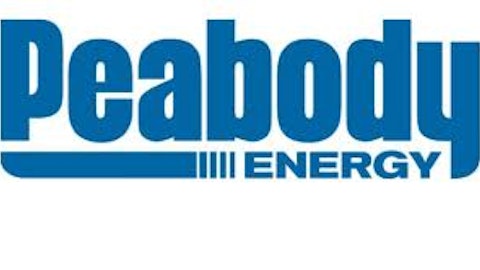It is worth noting that Peabody Energy Corporation (NYSE:BTU) is also the owner of the Caballo (#9) and Rawhide (#10) mines, which benefit from similar conditions.
In the most recent quarterly report (Q1 2013), the CEO seemed to be maintaining his bearish management tone but offered some optimistic guidance:
Peabody’s first-quarter results reflect the success of strong cost containment programs across the global platform. We continue to aggressively reduce costs, exercise capital discipline, maximize cash flows and reduce debt. Within global markets, U.S. coal demand is rebounding, Chinese and Indian coal imports are rising, and additional production rationalization and project delays are taking place.
First-quarter U.S. coal demand saw strong improvement over the prior year as generators switch back to coal and away from higher-priced natural gas in key regions. We now expect that during 2013, coal will recapture the vast majority of its 2012 demand that was lost to natural gas. – Gregory H. Boyce, Peabody Energy Corporation (NYSE:BTU) chairman and CEO
Survivor #2
The second-largest producer is the Black Thunder Complex, which is owned and operated by Arch Coal Inc (NYSE:ACI) .
This low-sulfur and highly-accessible coal is in high demand and yields attractive margins. Some seems measure more than 100 feet thick, which contributes to the staggering extraction rate of 4 tons of coal per second, 24 hours a day, seven days a week.
Coal from this complex is transported to 25 states, producing approximately 6% of the total electricity in the US.
The recent troubles that Arch Coal Inc (NYSE:ACI) has experienced were well forecast and the $70-million loss for Q1 2013 should have come as no surprise to anyone following this sector.
However, John W. Eaves, Arch Coal Inc (NYSE:ACI)’s president and chief executive officer may now be giving hints of an improving market paving the way for a turnaround story. He said,
Despite the global coal market headwinds that have prevailed over the last 18 months, we are delivering strong cost control, exercising capital restraint and minimizing cash outflows in the trough of the market cycle, while maintaining our commitment to safety and environmental excellence. As the market cycle turns, we are confident that our low-cost operations will generate strong cash flows and value for our shareholders.
Positive catalysts, such as normalized weather and higher competing fuel prices, are improving the outlook for the domestic thermal market, our largest market by volume,” continued Eaves. “We expect these trends to continue to reduce customer coal stockpiles throughout 2013 and to create a more balanced U.S. coal market thereafter. Globally, we believe metallurgical and thermal coal markets are in the process of stabilizing, and we anticipate gradual improvement as we progress through the remainder of the year. – John W. Eaves, Arch Coal Inc (NYSE:ACI) president and CEO
Conclusion
Major policy moves in the future to discourage coal are likely given the current political climate. But the greatest influence is still market prices. As natural gas prices increase so will coal demand.
This condition will benefit both Peabody Energy Corporation (NYSE:BTU) and Arch Coal Inc (NYSE:ACI) the most due to the margin advantages and ability to produce low-sulfur coal, that will see ever increasing demand due to government regulation. These two companies will survive, and if you are to believe both CEO’s, 2013 may be the bottom for the coal industry as global demand and domestic utilization both rebound.
The article Are There Diamonds in the Coal Patch? originally appeared on Fool.com and is written by James Catlin.
Copyright © 1995 – 2013 The Motley Fool, LLC. All rights reserved. The Motley Fool has a disclosure policy.




